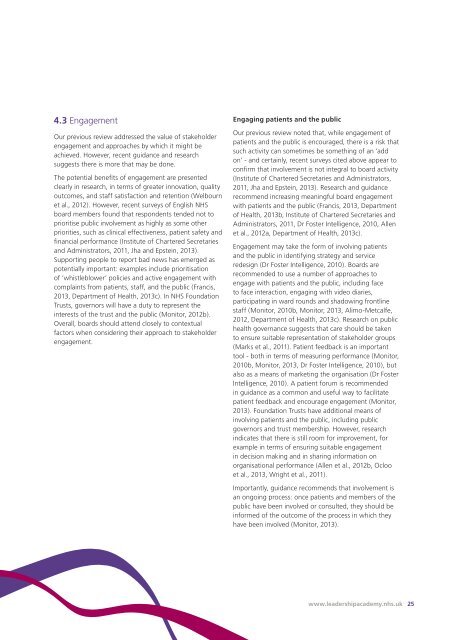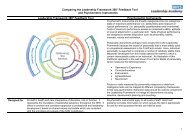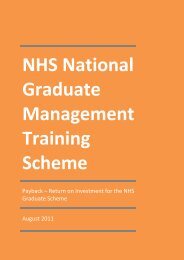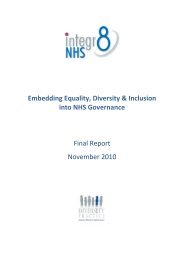Healthy NHS Board: a review of - NHS Leadership Academy
Healthy NHS Board: a review of - NHS Leadership Academy
Healthy NHS Board: a review of - NHS Leadership Academy
Create successful ePaper yourself
Turn your PDF publications into a flip-book with our unique Google optimized e-Paper software.
4.3 Engagement<br />
Our previous <strong>review</strong> addressed the value <strong>of</strong> stakeholder<br />
engagement and approaches by which it might be<br />
achieved. However, recent guidance and research<br />
suggests there is more that may be done.<br />
The potential benefits <strong>of</strong> engagement are presented<br />
clearly in research, in terms <strong>of</strong> greater innovation, quality<br />
outcomes, and staff satisfaction and retention (Welbourn<br />
et al., 2012). However, recent surveys <strong>of</strong> English <strong>NHS</strong><br />
board members found that respondents tended not to<br />
prioritise public involvement as highly as some other<br />
priorities, such as clinical effectiveness, patient safety and<br />
financial performance (Institute <strong>of</strong> Chartered Secretaries<br />
and Administrators, 2011, Jha and Epstein, 2013).<br />
Supporting people to report bad news has emerged as<br />
potentially important: examples include prioritisation<br />
<strong>of</strong> ‘whistleblower’ policies and active engagement with<br />
complaints from patients, staff, and the public (Francis,<br />
2013, Department <strong>of</strong> Health, 2013c). In <strong>NHS</strong> Foundation<br />
Trusts, governors will have a duty to represent the<br />
interests <strong>of</strong> the trust and the public (Monitor, 2012b).<br />
Overall, boards should attend closely to contextual<br />
factors when considering their approach to stakeholder<br />
engagement.<br />
Engaging patients and the public<br />
Our previous <strong>review</strong> noted that, while engagement <strong>of</strong><br />
patients and the public is encouraged, there is a risk that<br />
such activity can sometimes be something <strong>of</strong> an ‘add<br />
on’ - and certainly, recent surveys cited above appear to<br />
confirm that involvement is not integral to board activity<br />
(Institute <strong>of</strong> Chartered Secretaries and Administrators,<br />
2011, Jha and Epstein, 2013). Research and guidance<br />
recommend increasing meaningful board engagement<br />
with patients and the public (Francis, 2013, Department<br />
<strong>of</strong> Health, 2013b, Institute <strong>of</strong> Chartered Secretaries and<br />
Administrators, 2011, Dr Foster Intelligence, 2010, Allen<br />
et al., 2012a, Department <strong>of</strong> Health, 2013c).<br />
Engagement may take the form <strong>of</strong> involving patients<br />
and the public in identifying strategy and service<br />
redesign (Dr Foster Intelligence, 2010). <strong>Board</strong>s are<br />
recommended to use a number <strong>of</strong> approaches to<br />
engage with patients and the public, including face<br />
to face interaction, engaging with video diaries,<br />
participating in ward rounds and shadowing frontline<br />
staff (Monitor, 2010b, Monitor, 2013, Alimo-Metcalfe,<br />
2012, Department <strong>of</strong> Health, 2013c). Research on public<br />
health governance suggests that care should be taken<br />
to ensure suitable representation <strong>of</strong> stakeholder groups<br />
(Marks et al., 2011). Patient feedback is an important<br />
tool - both in terms <strong>of</strong> measuring performance (Monitor,<br />
2010b, Monitor, 2013, Dr Foster Intelligence, 2010), but<br />
also as a means <strong>of</strong> marketing the organisation (Dr Foster<br />
Intelligence, 2010). A patient forum is recommended<br />
in guidance as a common and useful way to facilitate<br />
patient feedback and encourage engagement (Monitor,<br />
2013). Foundation Trusts have additional means <strong>of</strong><br />
involving patients and the public, including public<br />
governors and trust membership. However, research<br />
indicates that there is still room for improvement, for<br />
example in terms <strong>of</strong> ensuring suitable engagement<br />
in decision making and in sharing information on<br />
organisational performance (Allen et al., 2012b, Ocloo<br />
et al., 2013, Wright et al., 2011).<br />
Importantly, guidance recommends that involvement is<br />
an ongoing process: once patients and members <strong>of</strong> the<br />
public have been involved or consulted, they should be<br />
informed <strong>of</strong> the outcome <strong>of</strong> the process in which they<br />
have been involved (Monitor, 2013).<br />
www.leadershipacademy.nhs.uk 25











